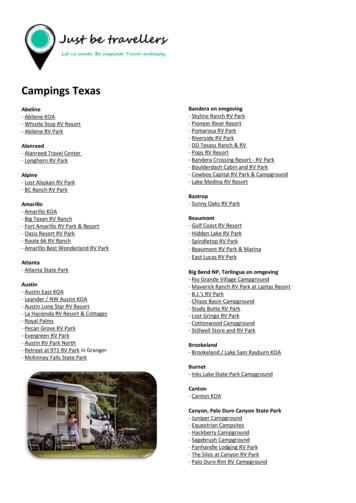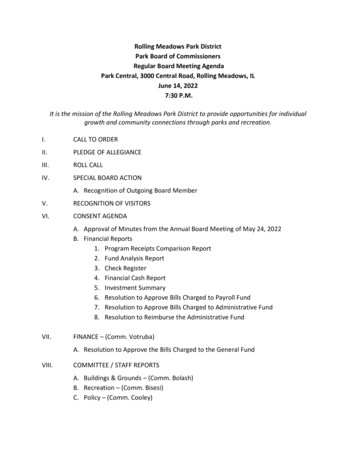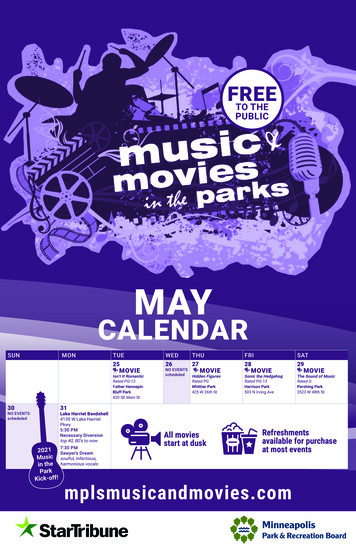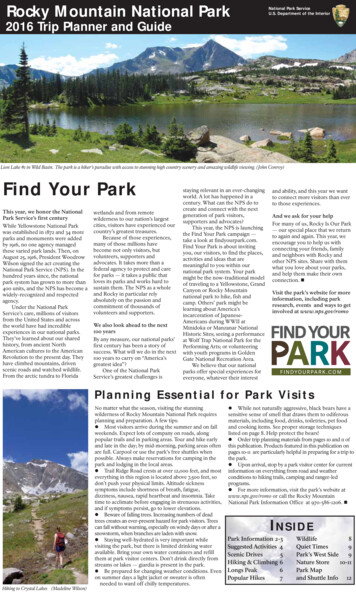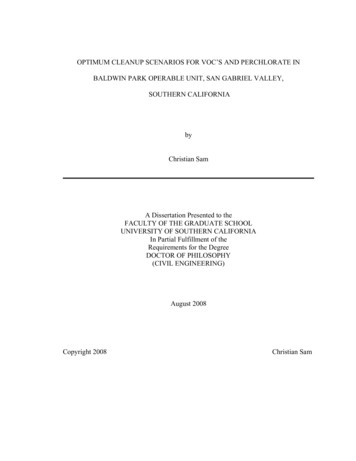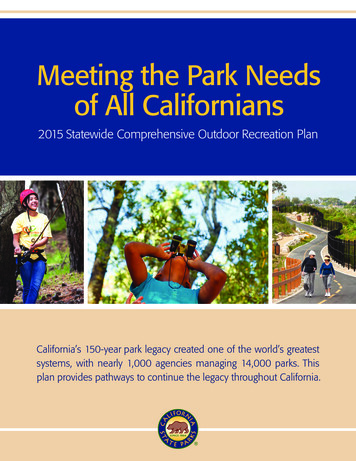
Transcription
Meeting the Park Needsof All Californians2015 Statewide Comprehensive Outdoor Recreation PlanCalifornia’s 150-year park legacy created one of the world’s greatestsystems, with nearly 1,000 agencies managing 14,000 parks. Thisplan provides pathways to continue the legacy throughout California.
ForwardThe California Department of Parks and Recreation has entered an exciting and challenging two-year, focused,effort to transform the State Park System. The February 2015 Parks Forward Commission report identified aParks Department that is in need of major operational improvements and recommended “A New Vision forCalifornia State Parks”. We have taken their advice seriously and prior to their final report, launched a two yearParks Transformation process that will fundamentally change how the Department’s services are providedin future years. The Transformation Team has developed an Action Plan that will enable the Department tobecome more relevant to California’s emerging diverse and underserved communities, to increase partnershipsof all kinds, to use the most advanced technology and management tools, and to develop excellentmanagement systems that will sustain and enhance our services for future generations. Additional informationabout the Transformation Team effort can be found by visiting www.parks.ca.gov/TransformationTeam.The Parks Forward Commission report highlights that oftentimes local park agencies are best at providingservices to local communities, especially traditionally underserved communities. California’s 2015 SCORPcomplements the Parks Forward Commission report and the efforts of the Transformation Team regardingincreasing park access to all Californians. This SCORP recognizes the important role that approximately 900 localagencies have in creating and maintaining close-to-home parks within communities throughout California.Together, we have an opportunity to achieve excellence as we transform California’s treasured park system intoa world class model; I invite you to join me in this pursuit.Lisa Ann L. Mangat, DirectorCalifornia Department of Parks and RecreationState Liaison Officer for the Land and Water Conservation FundTable of ContentsExecutive Summary. 1ICalifornia’s 150-Year Parks Legacy . 3IIWhy Parks and Recreation Matter. 7III California Develops New Tools to Assess Park Need. 15IV Improving Existing Parks. 19VSharing Success Stories. 21VI California’s Track Record of Parks Funding. 25VII The Action Plan. 27California Department of Parks and Recreation’s 2015 SCORP was funded by a LWCF Planning Grant.
Executive SummaryCalifornia State Parks’ 2015 Statewide Comprehensive Outdoor Recreation Plan(SCORP) reflects the current and projected changes in California’s population,trends and economy.A SCORP is required of every state in order to be eligiblefor grants from the Land and Water Conservation Fund(LWCF) Act. Over the past fifty years, LWCF grantshave created or improved over one thousand parksthroughout California. California’s 150-year park legacycreated one of the world’s greatest systems, with nearly1,000 agencies managing 14,000 parks. This planprovides pathways to continue the legacy throughoutCalifornia.This edition of the SCORP provides a strategy forstatewide outdoor recreation leadership and action tomeet the state’s identified outdoor recreation needs.This SCORP is a product of the California Departmentof Parks and Recreation (“State Parks”) that holds theauthority to represent and act for the State in dealingwith the Department of the Interior for purposes ofthe LWCF Act of 1965, as amended. The action plan isderived from public input and a statewide evaluation ofexisting park and recreation lands.Public participation for this SCORP’s developmentincluded:1. Focus Groups: 81 health and recreation expertsthrough six focus groups throughout the state.2. Director Survey: 295 public agency directorrespondents.3. Public Survey: 5,421 adults and 410 youthrespondents through the Survey on Public Opinionsand Attitudes (SPOA).California Develops New Toolsto Assess Park NeedThe California State Park’s new Geographic InformationSystems (GIS) tools represent the nation’s first interactivestatewide analysis of park availability and demographicinformation at the neighborhood level. This increasedinformation will allow for an analysis of park access toenhance park planning efforts for Californians. Thesetools are available at www.parks.ca.gov/SCORP.Meeting the Park Needs of All Californians 2015 Statewide Comprehensive Outdoor Recreation Plan 1
Henry Cowell Redwoods State Parkprovides Section 6(f)(3) protection to the entire parksite. Changes to a 6(f)(3) protected park to a use that isinconsistent with public outdoor recreation requires theNational Park Service’s approval.Section 6(f)(3) of the LWCF Act requires that propertyacquired or developed with LWCF assistance shall beoperated and maintained for public outdoor recreationin perpetuity. In many cases, even a relatively smallLWCF grant in a park of hundreds or thousands of acresProducts of California’s 2015 SCORP1.Meeting the Park Needs of All Californians: 2015Statewide Comprehensive Outdoor Recreation Plan2. Survey on Public Opinions and Attitudes on OutdoorRecreation in California (SPOA) document, and online SPOA tool7.“Parks for All Californians” website at www.parks.ca.gov/SCORP which includes links toproducts 1–6 and:Park Access Tool (GIS)Community Fact Finder Tool (GIS)3. Outdoor Recreation in California’s RegionsGrant Allocations Tool (GIS)4. Economic Study on Outdoor Recreation in CaliforniaExplanation of GIS tool data methods5. Alternative Camping SurveySuccess Stories clearinghouse6. California Recreational Trails System: CollaborativeLessons from the Pacific Crest Trail, California CoastalTrail, and Juan Bautista de Anza National HistoricTrail Reports and MapsPartners listing and links to their web sitesAction page with annual updatesCalifornia’s last SCORP was updated in 2008. This 2015 SCORP improves upon the 2008 SCORP. The seven productslisted above were developed with LWCF planning grants as part of California’s 2015 SCORP. This document summarizeskey findings, introduces new GIS tools to assess local park needs, and establishes priorities for statewide actionsincluding the use of LWCF allocations to California. For further guidance on how to submit LWCF funding applications,including Project Selection Criteria, go to www.parks.ca.gov/grants lwcf.2 Meeting the Park Needs of All Californians 2015 Statewide Comprehensive Outdoor Recreation Plan
I California’s 150-Year Parks LegacyYosemite Park in California set the stage for the legacy we enjoy today. In 1864,President Lincoln signed the Yosemite Grant Act, ensuring the land would be held forpublic use and recreation and would be inalienable for all time. The 150 years thatfollowed brought commitments for stewardship of open space and parks for nearlyhalf of the state’s 100 million land acres.Birth of State and National Parks in CaliforniaDuring the “Gilded Age” of the late 1800s, the effects of rapid urbanizationbegan to adversely affect the natural environment. Old growth forests andspectacular landscapes were being destroyed. Responding to this trend, theSempervirens Club, Sierra Club, and Save the Redwoods League promotedparks as a means of protecting California’s natural resources for futuregenerations.Early City Parks in CaliforniaDuring this same era, cities began developing parks to provide urbanresidents with close-to-home connections to nature. News outlets in thelate 1800s called parks “the lungs of the city”.Three examples of the nation’s most visited and largest city parks createdin the 1800s include: Balboa Park, San Diego (1868) Golden Gate Park, San Francisco(1870 State bonds built park; 1887built nation’s first public playground) Griffith Park, Los Angeles(1896 Griffith J. Griffithdonation of 3,015 acres toLos Angeles for recreation)Sempervirens Club, Big Basin Redwoods, 1902Building for the FutureThe state’s public lands legacy expansion became a reality through thestatewide bond acts, regional and local taxes, federal support and politicalplanning, and regulatory decisions. Through these opportunities, everyCalifornian has helped build this system by devoting taxes and support,often through volunteer assistance.Golden Gate Park, San FranciscoMeeting the Park Needs of All Californians 2015 Statewide Comprehensive Outdoor Recreation Plan 3
Understanding Park and Open Space DataCalifornia has a land mass of 100 million acres. Theanalysis in this SCORP (Section III, page 15) relies stronglyon the California Protected Areas Database (CPAD). CPADis a GIS inventory of all lands owned outright for park andopen space purposes by public agencies and certain nongovernmental organizations. Learn more about CPAD at:www.CALands.org.Defining Recreation Lands in the SCORPWhile California has a land mass of 100 million acres,this SCORP focuses on the 47 million acres statewide thatremain open and could be used for recreation. Theseareas include:In addition, some types of recreation locations are notincluded in CPAD at all, and therefore not included in theSCORP analysis: Schools are not counted in CPAD Sites that only provide indoor recreation (such as acommunity center that is not within a park) are notcounted in CPAD Private recreation lands, such as golf courses, privatelyowned hunting areas and commercial campgrounds Conservation easements held by public agencies orland trusts that usually are operating farms or ranches.These easements are tracked in the CaliforniaConservation Easement Database (learn more atwww.CALands.org/cced) City and neighborhood parks Outdoor recreation areas, such as greenway trailcorridors and public beaches Regional open space preserves and parks State and national wildlife areas Recreational lakes and reservoirs State and National parks and historic sitesBy number, parks are mostly owned by city, specialdistrict and county agencies National forests and other associated public landCityWho Owns Recreation Lands?CountyLands Not in SCORP AnalysisNot included in the SCORP’s focus on 47 million acres areother non-recreational open space lands in CPAD becausethey have restricted or no public recreation access.Examples are below: Areas of public land that do not have a formalrecreation use (such as a trail) and are not adjacent topublic recreation areas (such as some Bureau of LandManagement parcels) State and federal wildlife refuges that are closed orhave restricted permits for public access Other areas, including some watershed and relatedlands that are closed or have restricted permits forpublic access9,0001,200Special District1,700State631Federal500Non Profit, other45002,0004,0006,0008,00010,000By acres, parks and open space are mainly owned byfederal and state agenciesCity316,000County238,000Special District445,000State1,990,000FederalNon Profit, other210,000010mil4 Meeting the Park Needs of All Californians 2015 Statewide Comprehensive Outdoor Recreation Plan43,700,00020mil30mil40mil50mil
Park Partners Responding toPark NeedsCalifornia’s 150-year parks legacy has been createdthrough the actions of nearly 1,000 public agencies andnonprofits. These park partners reflect the diversity of thestate’s park needs: Local agencies — provide close-to-home heavilybuilt-out active recreation facilities, such as sportscourts/fields and community centers (plus somebroader open space roles) — includes city, county,special district/recreation districts.Regional agencies — conserve larger landscapes/habitats and provide hiking, camping, etc. in largeopen spaces — includes regional park and openspace districts and joint powers agencies.State agencies — preserve significant natural andcultural areas. Facility development in State Parks,by law, must complement parks’ natural/culturalintegrity. The Department of Fish & Wildlife, 10 stateconservancies, CALFIRE’s forest areas, lands of theDepartment of Water Resources, the State LandsCommission, and state university preserves allprotect fish and wildlife resources, forests, and broadareas of public land.Federal agencies — primarily conserve iconicnatural and cultural resources and sites, rather thanproviding developed recreation. This is accomplishedthrough the National Parks System, the refugesof the Fish and Wildlife Service, the vast NationalForests, deserts and other public lands overseenby the Bureau of Land Management and lakes andreservoirs from the Army Corps of Engineers and theBureau of Reclamation.Non profits / Other — land trusts and communityorganizations often own publicly accessiblepreserves and neighborhood parks or partner withpublic agencies to offer programs and services. Thehealth sector, foundations, and businesses contributefunding and the people of California volunteer timeand resources to support parks.Meeting the Park Needs of All Californians 2015 Statewide Comprehensive Outdoor Recreation Plan 5
State Parks’ Urban Parks Commitment – Los Angeles State Historic Park seeks to serve Californians in highly populated areas. The park addsgreen space, historic preservation, interpretive education and recreation to the busy metropolis of Los Angeles.The California Department of Parks and RecreationCalifornia has benefited greatly from this system ofboth public and private agencies that have made parksa priority. The California Department of Parks andRecreation serves an important role in this system. TheDepartment’s roles include the following: State Park System — Protect landscapes wherenature is primary and facilities complement naturaland cultural/historic values: 279 State Parks care for1.59 million acres for future generations, includingalmost one-third of California’s scenic coastline.Highway Motor Vehicle Recreation, and Office ofHistoric Preservation. Since 2000, the Departmentadministered over 2 billion in grants. Facilitate planning, technical assistance, andfunding partnerships — between the health sector,local park agencies, and other sectors to build healthiercommunities through new parks and programs.Develop and maintain the SCORP — Developanalysis, goals, tracking systems and range ofpartnerships to achieve plan, including facilitatingdiscussion and outreach about plan goals andprograms.Fund Local Needs — Develop and administerlocal assistance grant programs from bond actsor federally or state funded annual programsthrough the Office of Grants and Local Servicesand the Divisions of Boating and Waterways, Off-Morro Strand State Beach6 Meeting the Park Needs of All Californians 2015 Statewide Comprehensive Outdoor Recreation Plan
II Why Parks and Recreation MatterParks and recreation matter in many ways to California’s 38 million residents. Everyday, millions walk, ride, or run through parks, play with friends, and absorb thewonder of nature.Families and organizations have many needs; amongthem are the needs for recreation and access to theoutdoors. Parks and recreation: Support healthy, affordable, physical and socialactivities Improve the quality of life in communities as a formof social equity and environmental justice Provide venues for cultural celebrations that cananchor communities Are economic engines that fuel tourism, providejobs, and enhance the value of neighborhoods Preserve historic sites that connect Californians to thepast and safeguard its future Protect California’s inspiring vistas, natural resources,habitats, watersheds, forests, and wetlands.In addition to these direct benefits, the process ofplanning, creating, using, and improving parks cangenerate positive change. Community based planninggives stronger ties to one another and safeguards ourneighborhoods, bringing people and the governmentsthat serve them closer together.“It is so surreal to standhere knowing this willbecome a soccer park.It will build kindnessin our community.Here, youth will learnpride-with-purposeand become fit. Wehave seen kids turntheir lives aroundthrough sports.”Rafael Torres, Soccer Coach Statewide Park Program 3 milliongrant to City of San Pablo to createthe new Rumrill ParkMeeting the Park Needs of All Californians 2015 Statewide Comprehensive Outdoor Recreation Plan 7
Physical, Mental and Social HealthPublic parks and recreation opportunities serve asgateways to a healthier America.Recognition of many health challenges demands variousresponses. Parks can help with many if not most of thesechallenges: obesity; life expectancy; immune systems;general risk of disease; and overall quality of life.Parks as social meeting places also grow communityhealth — encouraging more volunteering, socialengagement, and civic pride. Parks provide affordableplaces to exercise. Youth join teams and enrichmentprograms in parks. Parks serve as strong catalysts inreclaiming urban run-down areas, and even contribute toenvironmental health — park vegetation can clean somepollutants improving local air quality.Examples of health benefits include: Adults and youth who live close to parks experiencehigher physical activity levels. An international study bythe University of Exeter’s Medical School (Environ. Sci.Technol., 2014, 48 (2). pp 1247–1255) also foundthat parks nearby provide psychological benefits — asmuch as a one-third decrease in mental health issues(anxiety, depression).Adolescents with easy access to multiple recreationfacilities experience more physical activity and areless likely to become overweight or obese thanadolescents without access to such facilities.City of Paramount, Salud Park In distressed neighborhoods where vacant lots wereconverted into small parks and community greenspaces, residents reported significantly less stress andmore exercise, according to a 2011 study published inthe American Journal of Epidemiology. Through a youth community gardening programimplemented by 20 park and recreation agencies,51 percent of participants reported eating more fruitsand vegetables. Parks can provide fresh food throughcommunity gardens, horticultural, and fruit tree orchards.The health benefits of parks aren’t just a matter of feelingpositive about park-based recreation: a 2011 studyconducted on a city park and recreation system revealedthat the city’s residents were able to save 64 million inannual medical costs as a result of getting physical activity incity parks. For individuals, the annual medical cost differencebetween being active or not was as much as 250–500.“I made it a goal to walk twomiles each day on thispark’s track with a group ofretired friends. Then I usethe outdoor gym equipment.I lost many pounds. It is apositive movement to ahealthy lifestyle.”Gale Swain 4.6 million Statewide ParkProgram grant to City of Paramount for thenew Salud Park8 Meeting the Park Needs of All Californians 2015 Statewide Comprehensive Outdoor Recreation Plan
The Importance of Play Areas forChildrenPlay is vital for the health in children. Health professionalsagree that the decline of active outdoor play in childhoodis linked to the rise of childhood obesity, Type 2diabetes, and decreased life expectancy. The AmericanAcademy of Pediatrics, in its 2007 clinical report titled“The Importance of Play in Promoting Healthy ChildDevelopment and Maintaining Strong Parent-Child Bonds,”urged doctors to advocate for active free play as anessential part of every child’s physical health.A 2004 study by Frances Kuo and Andrea Taylor,published in the American Journal of Public Health,found that play and other activities conducted in greenoutdoor settings significantly reduced the symptomsof attention deficit/hyperactivity disorder (ADHD)in children. The number of children diagnosed withattention problems has skyrocketed in recent years.Free play is the engine of learning in childhood — avital force in children’s cognitive, social, and emotionaldevelopment. Providing rich and stimulating outdoorenvironments for children to play is important.Top right: Packard Foundation Summer Learning Program,Samuel P. Taylor State ParkBottom right: Calaveras Big Trees State ParkThe Children’s Outdoor Bill of Rights was developed by the California Roundtable onRecreation, Parks and Tourism and has this objective: Every child in California, by thecompletion of their 14th year, should have the opportunity to experience each of theseactivities: Play in a safe place Follow a trail Go boating Explore nature Camp under the stars Connect with the past Learn to swim Ride a bike Plant a seed Go fishingMore information at http://calroundtable.org/Copy of cobor.htm.Meeting the Park Needs of All Californians 2015 Statewide Comprehensive Outdoor Recreation Plan 9
Removal of Blight to Create a Park — “Our community is polluted and unhealthy. Wehave been trying to get people to hear us that we need a park with trees, grass, lighting,a place to socialize, exercise and play. Turning this site into a park will improve ourcommunity image.”Matitza Lopez Statewide Park Program 5 million grant to City of Los Angeles to create the new Slauson Wall ParkEnvironmental JusticeWhile the concept of environmental justice grew outof the disproportionate placement of harmful facilities(dumps, refineries, toxic sites) near people of colorand of below average incomes, it applies here, too:the absence of positive things, like parks, can also beharmful. Communities need nearby parks to enjoy manyof the benefits described in this section.Research findings (Godbey and Mowen: The Benefits ofPhysical Activity: The Scientific Evidence) also show thatchildren who live close to public parks and recreationfacilities are more likely to be active. Given the hugechallenge of obesity facing so many children, particularlychildren of color, anything that increases active living isa matter of justice, as well as of health. Public parks alsoprovide a pathway to enrichment programs that are moreeasily available to more well-off communities, such asspecial camps, gyms, and private sports activities.Critical to addressing environmental justice is thedevelopment of a positive sense of community. Parkscan beautify areas of blight. Parks serve as grand meetingplaces of diverse populations. Engaging with all of ourdiversity on a regular basis is something that nearby parkscan easily offer — and all of society benefits as the bondsof citizenship grow through these interactions.10 Meeting the Park Needs of All Californians 2015 Statewide Comprehensive Outdoor Recreation Plan
Celebration of Cultural HeritageCalifornia, as one of the nation’s most diverse states,contains parks that are actively used to celebrate culturalheritages. Memorials about the park sites themselves,with stories placed into interpretive facilities, public art,and interpretive programs, show the depth of California’sdiverse heritage.The festivals and celebrations of all types that take placein parks represent important cultural assets. From birthdayparties and weddings, to national and internationalholidays, to festivals and special performances, parksembody California’s collective culture.Parks that provide for a variety of cultural expressionsrepresent places where residents come together to learnabout their own heritage and the heritages of theircommunity.Top left corner: Indian Grinding Rock, State Historic Park (SHP)Right column, top to bottom: Colonel Allensworth SHP volunteer,Historic Old Town San Diego volunteers (two middle photos), andSutter’s Fort SHPMeeting the Park Needs of All Californians 2015 Statewide Comprehensive Outdoor Recreation Plan 11
La Purisima Mission, State Historic Park,LompocPreservation of HistoryCalifornia’s human history extends back centuries. Parks can preserve the landscapes and artifacts of this lineage.Whether following a guide book on a trail, listening to a docent or ranger explain a feature, or just taking in history bysight, parks play a strong role in preserving a roadmap to the state’s communities, economies, and ecology.The Tomol Interpretive Play Area atCarpinteria State Beach — Few areas invitechildren to enjoy healthy outdoor play whilethey learn about California’s colorful history.The Tomol Interpretive Play Area is one ofthese special places. This unique facility letskids run, jump, slide and have fun while itencourages them to imagine living in aChumash Indian Village.12 Meeting the Park Needs of All Californians 2015 Statewide Comprehensive Outdoor Recreation Plan
Tourism, Jobs and OtherEconomic BenefitsOne cannot travel far in California before seeing alocal park, a regional reserve, a national forest or park,or many other types of the state’s protected openlands. These lands represent more than just playspaces or scenic wonders — they are strong economiccontributors:jobs Thousands of people holdin parks and inrelated programs — rangers, support staff, peoplewho run science programs for kids, weddingplanners, and more. Thousands ofthrive on thesupport of nearby parks, or recreation generally(sports leagues, hunting, fishing, camping, hiking,etc.) — outfitters, restaurants, hotels, motels, andB&Bs. Parks, including state beaches, bring tourists fromall over the world — in San Diego, one estimateplaced the value of park-relatedfor the county at 40 million, including hoteland food fees, sales taxes, rentals, and otherexpenditures (see sidebar for statewide analysis).businessestourism increase home valuesParksimmediately near them by 5–15 percent,according to an estimate by The Trust for PublicLand, helping property owners and boosting localproperty taxes.“ecosystem services”Parks providewith large economic benefits — the savings fromgroundwater capture and cleansing alone are aninvaluable but often hidden financial contributionof parks.An Outdoor Industry Association report finds thatall types of private and public recreation (beyondspending related to public parks) generates 85 billion in consumer spending and732,100 jobs in California. To learn more goto: mlHearst San Simeon, State Historical MonumentEconomic Value of Public Parks inCaliforniaPark Types(number of)Sales*Jobs**City, County and RegionalParks (12,000) 10 billion196,000State Parks (630, includesall state agencies) 4.3 billion56,000Federal Parks (500, includesall federal agencies) 7.1 billion61,000Average Total Per Year 21.4 billion 313,000Chart based on 2010 BBC Research & Consulting report to CaliforniaState Parks.*Sales include travel and related expenditures (lodging, meals,gas) and team and other sports equipment). **Jobs include parkpersonnel and indirect employment from recreation-relatedexpenditures. Park numbers do not include approximately 500nonprofit and private parks in total CPAD inventory.Meeting the Park Needs of All Californians 2015 Statewide Comprehensive Outdoor Recreation Plan 13
Protection of Natural ResourcesWetlands ConservationAnother important benefit of parks includes theprotection of natural resources needed for all life.Protection roles include:The future of wetlands is a critical matter; therefore, eachSCORP includes priorities for wetlands. Conservation of biodiversity — California is wellrenowned for the richness of its plant and animalspecies, and for their uniqueness. Parks and otherprotected space are vital to ensure natural balance.Green Infrastructure — In metropolitan areas, parkscapture rain water and storm flows. These “greensolutions” help control sediment, flooding, urban heatisland effects and pollution.Iconic landscapes — Areas of outstanding beautyare frequently preserved in parks — special view points,coastlines, bays, meadows, valleys, mountain rangesare all vital to California’s heritage and well-being, andmotivate people to protect and support parks. Since European settlement, ninety percent of theoriginal inland wetland landscapes of California havebeen lost. These losses are due to agriculture, urbandevelopment, and other human actions. Coastal wetland loss is even more severe, with onlyfive percent of original wetlands remaining.California’s Wetland Conservation Policy mandates “nooverall net loss and a long-term net gain in the quantity,quality, and permanence of wetland acreage”. As such,wetlands are protected by many federal and state laws,regulations and policies to prevent further degradationand destruction.The natural resource value of parks becomes moreimportant every year as the press of population growthchallenges landscapes and natural systems. This growth isnow projected at 20 percent over the next quarter century.(California Department of Finance)The California Wetland Monitoring Workgroupincludes federal, state and local agencies workingto “coordinate monitoring activities, establish priorities,resolve existing inconsistencies, and facilitatecommunication am
California's 150-year park legacy created one of the world's greatest . systems, with nearly 1,000 agencies managing 14,000 parks. . Griffith Park, Los Angeles (1896 Griffith J. Griffith donation of 3,015 acres to Los Angeles for recreation) 4 . such as golf courses, privately



